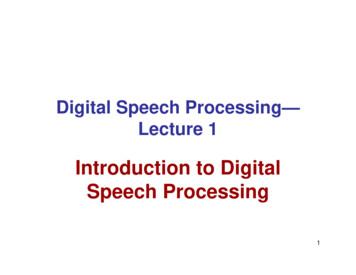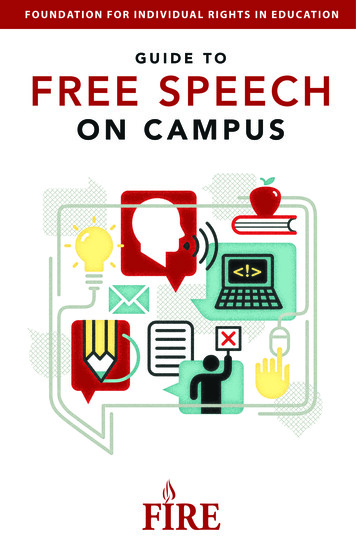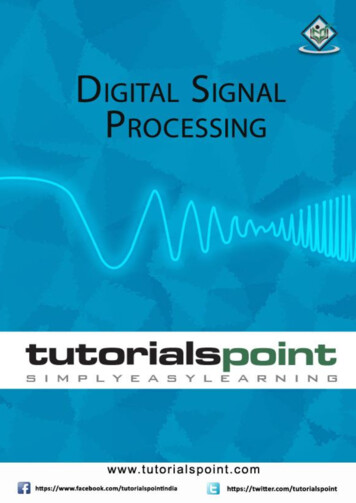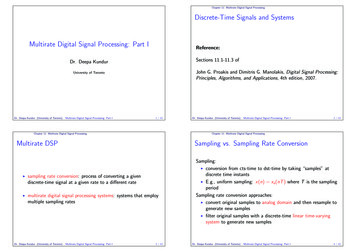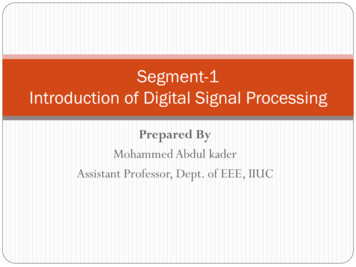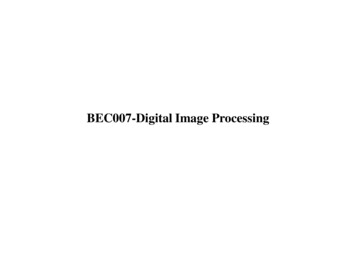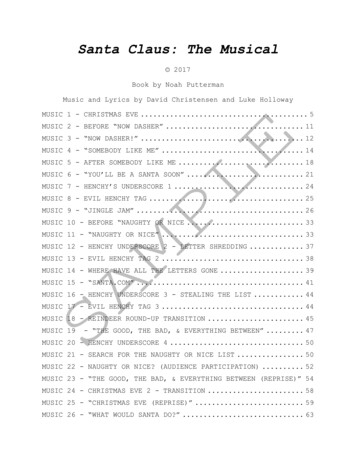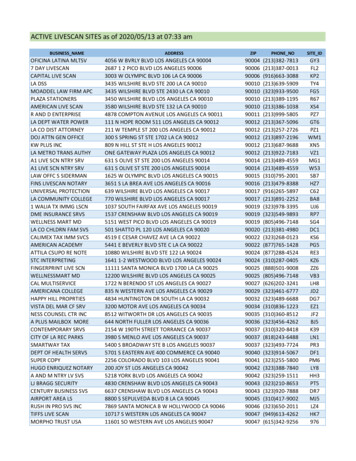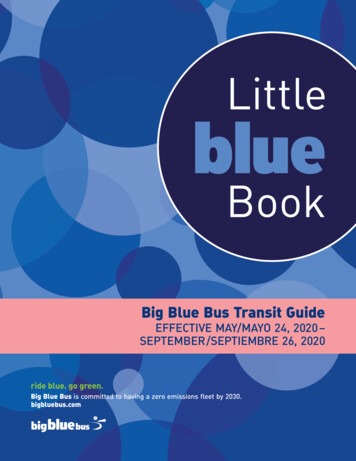
Transcription
Digital Speech ProcessingProfessor Lawrence RabinerUCSBDept. of Electrical and ComputerEngineeringJan-March 20131
Course DescriptionThis course covers the basic principles of digital speech processing:––––Review of digital signal processingMATLAB functionality for speech processingFundamentals of speech production and perceptionBasic techniques for digital speech processing: short - time energy, magnitude, autocorrelationshort - time Fourier analysishomomorphic (convolutional) methodslinear predictive methods– Speech estimation methods speech/non-speech detectionvoiced/unvoiced/non-speech segmentation/classificationpitch detectionformant estimation– Applications of speech signal processing Speech coding Speech synthesis Speech recognition/natural language processingA MATLAB-based term project will be required for all students takingthis course for credit.2
Course Information Textbook: L. R. Rabiner and R. W. Schafer,Theory and Applications of Digital SpeechProcessing, Prentice-Hall Inc., 2011 Grading:––––HomeworkTerm ProjectMid - Term ExamFinal Exam20%20%20%40% Prerequisites: Basic Digital Signal Processing,good knowledge of MATLAB Time and Location: Tuesday, Thursday, 10:00am to 11:20 am, Phelps 1437. Course Website:www.ece.ucsb.edu/Faculty/Rabiner/ece259 Office Hours: Tuesday, 1:00-3:00 pm3
Web Page for Speech CourseClick onDigitalSpeechProcessingCourseon left-sidepanel4
Web Page for Speech CourseDownloadcourselecture slides5
Web Page for Speech CourseCourselecture slides(6-to-page)6
Web Page for Speech CourseDownloadhomeworkassignments,speech files7
Web Page for Speech CourseDownloadMATLAB (.m)files; ExamineProjectSuggestions8
Course ReadingsRequired Course Textbook: L. R. Rabiner and R. W. Schafer, Theory andApplications of Digital Speech Processing, PrenticeHall Inc., 2011Recommended Supplementary Textbook: T. F. Quatieri, Principles of Discrete - Time SpeechProcessing, Prentice Hall Inc, 2002Matlab Exercises: C. S. Burrus et al, Computer-Based Exercises for SignalProcessing using Matlab, Prentice Hall Inc, 1994 J. R. Buck, M. M. Daniel, and A. C. Singer, ComputerExplorations in Signals and Systems using Matlab,Prentice Hall Inc, 20029
Recommended References J. L. Flanagan, Speech Analysis, Synthesis, and Perception,Springer -Verlag, 2nd Edition, Berlin, 1972J. D. Markel and A. H. Gray, Jr., Linear Prediction of Speech,Springer-Verlag, Berlin, 1976B. Gold and N. Morgan, Speech and Audio Signal Processing, J.Wiley and Sons, 2000J. Deller, Jr., J. G. Proakis, and J. Hansen, Discrete - TimeProcessing of Speech Signals, Macmillan Publishing, 1993D. O’Shaughnessy, Speech Communication, Human and Machine,Addison-Wesley, 1987S. Furui and M. Sondhi, Advances in Speech Signal Processing,Marcel Dekker Inc, NY, 1991R. W. Schafer and J. D. Markel, Editors, Speech Analysis, IEEEPress Selected Reprint Series, 1979D. G. Childers, Speech Processing and Synthesis Toolboxes, JohnWiley and Sons, 1999K. Stevens, Acoustic Phonetics, MIT Press, 1998J. Benesty, M. M. Sondhi and Y. Huang, Editors, Springer Handbookof Speech Processing and Speech Communication, Springer, 2008.10
References in Selected Areas of SpeechProcessingSpeech Coding: A. M. Kondoz, Digital Speech: Coding forLow Bit Rate Communication Systems-2ndEdition, John Wiley and Sons, 2004 W. B. Kleijn and K. K. Paliwal, Editors, SpeechCoding and Synthesis, Elsevier, 1995 P. E. Papamichalis, Practical Approaches toSpeech Coding, Prentice Hall Inc, 1987 N. S. Jayant and P. Noll, Digital Coding ofWaveforms, Prentice Hall Inc, 198411
References in Selected Areas of Speech ProcessingSpeech Synthesis: T. Dutoit, An Introduction to Text - To-SpeechSynthesis, Kluwer Academic Publishers, 1997 P. Taylor, Text-to-Speech Synthesis, CambridgeUniversity Press, 2008 J. Allen, S. Hunnicutt, and D. Klatt, From Text to Speech,Cambridge University Press, 1987 Y. Sagisaka, N. Campbell, and N. Higuchi, ComputingProsody, Springer Verlag, 1996 J. VanSanten, R. W. Sproat, J. P. Olive and J.Hirschberg, Editors, Progress in Speech Synthesis,Springer Verlag, 1996 J. P. Olive, A. Greenwood, and J. Coleman, Acoustics ofAmerican English, Springer Verlag, 199312
References in Selected Areas of SpeechProcessingSpeech Recognition: L. R. Rabiner and B. H. Juang, Fundamentals ofSpeech Recognition, Prentice Hall Inc, 1993 X. Huang, A. Acero and H-W Hon, Spoken LanguageProcessing, Prentice Hall Inc, 2000 F. Jelinek, Statistical Methods for Speech Recognition,MIT Press, 1998 H. A. Bourlard and N. Morgan, Connectionist SpeechRecognition-A Hybrid Approach, Kluwer AcademicPublishers, 1994 C. H. Lee, F. K. Soong, and K. K. Paliwal, Editors,Automatic Speech and Speaker Recognition, KluwerAcademic Publisher, 199613
References in Digital Signal Processing A. V. Oppenheim and R. W. Schafer, Discrete Time Signal Processing, 3rd Ed., Prentice-HallInc, 2010 L. R. Rabiner and B. Gold, Theory andApplication of Digital Signal Processing, PrenticeHall Inc, 1975 S. K. Mitra, Digital Signal Processing-AComputer-Based Approach, Third Edition,McGraw Hill, 2006 S. K. Mitra, Digital Signal Processing LaboratoryUsing Matlab, McGraw Hill, 199914
The Speech StackSpeech Applications — coding, synthesis,recognition, understanding, verification,language translation, speed-up/slow-downSpeech Algorithms— speech-silence(background), voiced-unvoiced, pitchdetection, formant estimationSpeech Representations — temporal,spectral, homomorphic, LPCFundamentals — acoustics, linguistics,pragmatics, speech production/perception15
Digital Speech ProcessingAbility to implementtheory and conceptsin working code(MATLAB, C, C )Basic understandingof how theory isappliedMathematics,derivations, signalprocessingNeed to understand speech processing at allthree levels16
Course Outline – ECE 259A – Speech Processing Jan 8 - Lecture 1, Basic Course Material; Introduction to Digital Speech ProcessingJan 10 - Lecture 2a, Review of DSP FundamentalsJan 15 - Lecture 2b, Review of DSP FundamentalsJan 17 - Lecture 3a, Acoustic Theory of Speech ProductionJan 22 - Lecture 3b, Lecture 4, Speech Perception—Auditory ModelsJan 24 - Lecture 5, Sound Propagation in the Vocal Tract -- Part 1Jan 29 - Lecture 6, Sound Propagation in the Vocal Tract -- Part 2Jan 31 - Lecture 7, Time Domain Methods -- Part 1Feb 5 Lecture 8, Time Domain Methods -- Part 2Feb 7 Lecture 9, Frequency Domain Methods -- Part 1Feb 12 - Lecture 10-11, Frequency Domain Methods -- Part 2Feb 14 - Mid - Term ExamFeb 19 - Lecture 12a, Homomorphic Speech Processing -- Part 1Feb 21 - Lecture 12b, Homomorphic Speech Processing -- Part 2Feb 26 - Lecture 13, Linear Predictive Coding (LPC) -- Part 1Feb 28 - Lecture 14, Linear Predictive Codeing (LPC) -- Part 2Mar 5 Lecture AlgorithmsMar 7 Lecture 15, Speech Waveform Coding -- Part 1Mar 12 - Lecture 16, Speech Waveform Coding -- Part 2Mar 14 - Term Project Presentations (8-12 noon)Mar 19 - Final Exam (8 am-11 am)17
Other Potential Topics forDiscussion/Term Projects Sinusoidal modeling of speech Speech modification and enhancement—slowing down and speeding up speech, noisereduction methods Speaker verification methods Music coding including MP3 and AACstandards-based methods Pitch detection methods18
Term Project All registered students are required to do a term project.This term project, implemented using Matlab, must be aspeech or audio processing system that accomplishes asimple or even a complex task—e.g., pitch detection,voiced-unvoiced detection, speech/silence classification,speech synthesis, speech recognition, speakerrecognition, helium speech restoration, speech coding,MP3 audio coding, etc. Every student is also required to make a 10-minutePower Point presentation of their term project to theentire class. The presentation must include:– A short description of the project and its objectives– An explanation of the implemented algorithm and relevant theory– A demonstration of the working program – i.e., results obtainedwhen running the program19
Suggestions for Term ch detector – time domain, autocorrelation, cepstrum, LPC, etc.Voiced/Unvoiced/Silence detectorFormant analyzer/trackerSpeech coders including ADPCM, LDM, CELP, Multipulse, etc.N-channel spectral analyzer and synthesizer – phase vocoder, channelvocoder, homomorphic vocoderSpeech endpoint detectorSimple speech recognizer – e.g. isolated digits, speaker trainedSpeech synthesizer – serial, parallel, direct, latticeHelium speech restoration systemAudio/music coderSystem to speed up and slow down speech by arbitrary factorsSpeaker verification systemSinusoidal speech coderSpeaker recognition systemSpeech understanding systemSpeech enhancement system (noise reduction, post filtering, spectralflattening)20
MATLAB Computer ProjectThe requirements for this project are a shortdescription of the problem containingrelevant mathematical theory and objectivesof the project, a listing (with sufficientdocumentation and comments) of theprogram, and a demonstration that theprogram works properly.21
3 Course Information Textbook: L. R. Rabiner and R. W. Schafer, Theory and Applications of Digital Speech Processing, Prentice-Hall Inc., 2011 Grading
